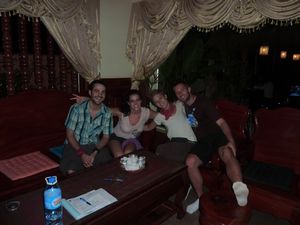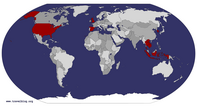Advertisement
Published: December 4th 2010

 Golden Mango
Golden Mango
A&L with AJ and Jeff, our new Canadian friendsCambodia: A Country of Contrasts
From the majestic prangs of Angkor Wat to the Killing Fields of Choeung Ek, Cambodia has filled us with emotion. It all began when we crossed the border.
That first emotion was anxiety. The Thai/Cambodian border was as chaotic and stressful as anywhere we’ve been. The anxiety had nothing to do with risk; we never felt as though we were in any danger. The real concern was being taken advantage of or robbed of our possessions. We had read quite a bit of information about crossing the border to prepare for it, and every source was telling us to beware of scams. We were both on edge during our approach, but felt equipped to make our way across. The bus dropped us at the border to cross by foot and after successfully dodging a few text book scams, one of which consisted of a “government official” who was selling us our processing papers for an inflated price, we met some friendly Canadians who were willing to go into a negotiating battle with us against the Khmers (the Cambodian people) to share transport to Siem Reap. As we tried to find a taxi for a
fair price, we were consistently wary of those who seemed a little too interested in our packs. The swarming posse of taxi drivers and commission boys, who had been in our faces since we got off the bus, was left in the dust as we began the two hour trip to Siem Reap for the reasonable price of $30 (the original asking price was $60). We were home free.
Upon arrival to the town of Siem Reap we found our hotel, the Golden Mango. From the moment we walked through the doors, our perception of Cambodians took an immediate swing from persistent harassers to hospitable hosts. We were asked to take off our shoes (the place was immaculately clean), given a welcome drink, cool towel and an introduction to the hotel and the area of Angkor. We felt like we had hit the jackpot.
The main attraction of Siem Reap, and Cambodia for that matter, is Angkor Wat. Angkor Wat is the national pride of Cambodia, enough so that it is represented on the nation’s flag. Built between the 10th and 12th centuries and considered by many as an “8th wonder of the world”, we couldn’t wait to
get out and explore the temple complexes. With over 800 documented ruins, there is enough here to keep some tourists busy for weeks on end. We analyzed the different approaches to visiting the area and to avoid becoming “templed-out,” decided to stick to the two main loops.
Per suggestion of our hotel, we traveled by tuk-tuk around the Grand Tour first; this included the further temples and those that aren’t considered as grandiose. The first temple we saw was a Hindu Temple dedicated to Shiva named Banteay Srey. The drive out to the temple was quite a treat because it gave us a little more insight into Cambodian rural life; however, the intricate carvings on red sandstone made this temple one of our favorites. Before the day was done we had visited seven different sites along the Grand Tour. While each one was unique, out next favorite was Preah Kahn, which is believed to have been the home to more than one thousand teachers and perhaps a Buddhist University. At the end of the day we joined the crowd who were gathered at Phnom Bakheng Temple to watch the sunset before heading back to our hotel for a much
needed emergency cocktail.
Our plan for day two was to visit the smaller, yet more revered inner loop of Angkor Wat. We and our Canadian friends from the border crossing, AJ and Jeff, were thrilled with our decision to hire a tour guide for the day. Si Len’s extensive knowledge of the area enabled us to see beyond the beauty of the temple decorations and actually allowed us to gain insight into the complex and interesting history of Angkor Wat. Ta Prohm, where the movie Tomb Raider was filmed, was a Buddhist Temple built by King Jayavarman VII for his mother in the 12th century (he was considered the greatest Angkorian king). The shadows cast by the century’s old trees whose roots are now part of the infrastructure of the temple walls are really what set this temple apart and made it our second favorite. We also visited the tremendous city of Angkor Thom and Bayon Temple. However, not surprisingly, we were the most awestruck by Angkor Wat which is the only structure that has been used continuously since it was built. Hindus and Buddhists alike still come to pray at this magnificent, spiritual center. We are definitely glad
that we made it to Angkor, to both feel the splendor of this ancient civilization and see the pride that it continues to inspire in the Khmer people.
From Siem Reap, we made our way by bus to the capital, Phnom Penh. “Nom Penn” as it is known in the Western world, is a city that is trying to emerge from a troubled past. Even with a few decent highlights to the city, such as a quaint promenade, beautifully constructed pagodas and impressive museums, it seems that the trauma that the capital city experienced makes it a place where rules don’t always apply. This was apparent to us in two main ways, the traffic and the street vendors. The massive number of motorbikes, tuk-tuks, bicycles, and cars will mow you down if you’re not careful (sidewalk included). It is quite the challenge crossing the street when you don’t know which way to look. The street vendors just won’t take “no” for an answer. It is testing to ones patience to say “no thank you” 20 or 30 times before they leave you alone. While we were annoyed at first, once we began reading into the history of Cambodia and
started talking with the locals, we began to understand. With a high level of poverty and corruption, it became clear that traffic violations aren’t top priority and that the vendors are simply working to survive.
Cambodia seems to be a country that gets lost in the mix of American’s exposure to world history. Other than the obvious ties to U.S. history, such as the Vietnam War and a few other names and dates in our general knowledge base, we were ignorant to most of Southeast Asia’s broad history prior to this trip. One name that we had heard, but knew little about was Pol Pot. It was in the visiting of Phnom Penh that we learned Cambodia’s dark side.
In 1975, two weeks before Saigon fell after the Vietnam/American war, Cambodia was taken over by an extreme Maoist party called the Khmer Rouge. Lead by Pol Pot, the idea was to transform Cambodia, renamed Democratic Kampuchea, into a ‘giant peasant dominated agrarian cooperative.’ There would be no social class, no money, no education system and no privatization of any kind. Among others, teachers, scientists, doctors, engineers, religious leaders, and potential traitors to the new system were systematically tortured
and killed. The entire country became a slave camp, forced to work in rice fields between 12-15 hours a day while being fed next to nothing. It is roughly estimated that under the Khmer Rouge regime from 1975-1979, two million Cambodians were murdered by their fellow countryman Pol Pot and his party.
We visited two places to give us perspective on this genocide; Tuol Sleng Prison and the Killing Fields of Choeung Ek. Tuol Sleng, better known as S-21, was a high school downtown that was transformed into the central detention and torture center for the Khmer Rouge regime. Visiting the eerie Tuol Sleng opened our eyes, chilled our bones and saddened our hearts. It is impossible to conceptualize the brutal atrocities that occurred only 35 years ago. The once prison has since been preserved as a museum in memory of the men, women and children who heartbreakingly lost their lives for no reason. The Killing Fields of Choeung Ek, where thousands of prisoners from S-21 were transported, executed, and buried in mass graves, was equally as difficult to visit. The memorial building where the bones of the excavated graves now lay to rest, allows the visitors to pay
their respect. It is hard not to shed a tear when learning about this horrific act of violence. If you want more information, you can visit the Documentation Center of Cambodia at www.dccam.org.
In Cambodia we did not run into a single American traveler. This is not to say that we were the only Americans, but the majority of the travel scene is made up of French, Australians, Germans, Koreans, and a few others. In visiting Cambodia we realized that it has a lot to offer. Angkor Wat should definitely be on every traveler’s bucket list, and exposure to the Khmer Rouge genocide is important so that we can learn from the mistakes of the past. We were so glad that we had the opportunity to visit this spellbinding nation and experience the extreme highs and lows of its history. We hope to see Cambodia flourish and definitely recommend a visit for the adventurous.
Advertisement
Tot: 0.217s; Tpl: 0.013s; cc: 17; qc: 94; dbt: 0.1118s; 1; m:domysql w:travelblog (10.17.0.13); sld: 1;
; mem: 1.3mb


























greg
non-member comment
Thanks
Thanks for sharing these pictures keep it up